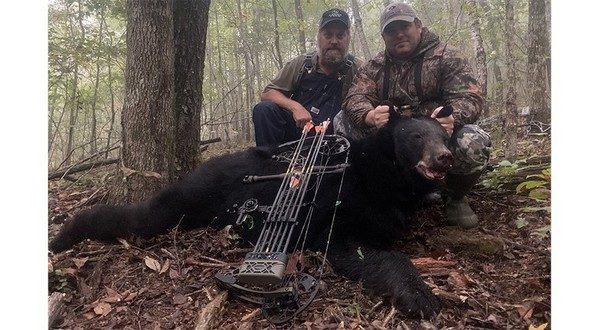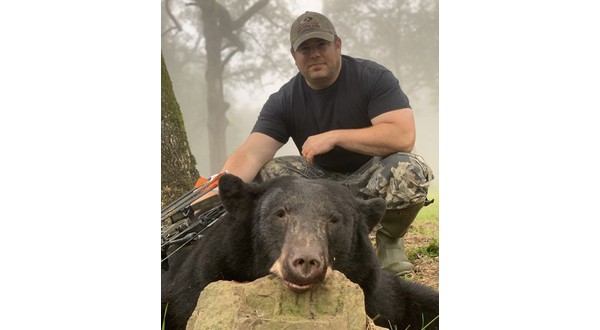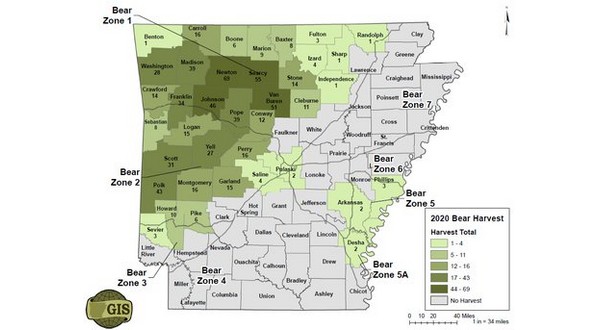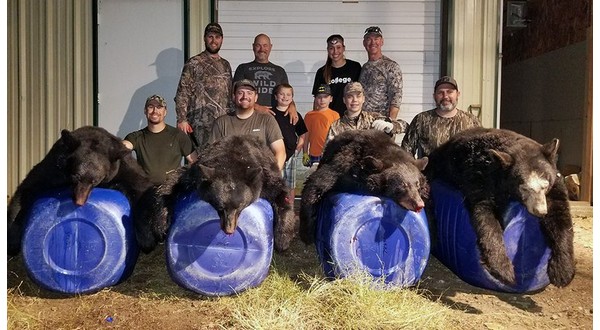
LITTLE ROCK, Ark. — In the world of wildlife management, harvest records usually are broken by small percentages. But bear hunters in Arkansas broke the record of 577 set during the 2018 season by taking 665 in 2020 — a jump of 15%.”The increase of almost 100 bears was largely due to two factors: The fact that there was a sparse mast crop across the state and the fact that we increased the bear zone quota from 345 bears to 500 bears,” Myron Means, Arkansas Game and Fish Commission large carnivore program coordinator, said during the January commission meeting.
Archers took 536 bears (80% of the total), hunters using muzzleloaders took 77 (12%) and modern gun users took 52 (8%).
“This is nothing that’s really unique to Arkansas but it’s kind of prominent to bear hunting in general, the fact that 80% of the bears are harvested with archery equipment,” Means said.
“Not to say that muzzleloaders and modern guns do not make an impact in the harvest, but they’re not as near significant methods as archery equipment. The simple reason behind that is most people bait and most people bear hunt early in the season, as soon as the season opens, and really kind of do the damage, as far as harvesting bears, most of the time within the first couple of weeks of archery season.”

Bear season began with archery Sept. 26-Nov. 30. Muzzleloader season was Oct. 17-25 and modern gun season stretched from Nov. 14 until Dec. 6 across four zones. Zone 1 (Ozark Mountains) had the lion’s share of the harvest with 458 (242 males, 215 females). The zone 2 (Ouachita Mountains) total was 200 (105 males, 95 females). Zones 5 and 5A in southeastern Arkansas accounted for seven bears. Of the 665 total, 348 were males and 317 were females.
“The sex ratios lined out really well, as they have in the past,” Means said. “You always want to harvest more males than females across the state and we had 52% males and 48% females, which is about where you need to be.”
Public vs. Private
Means says hunters harvest more bears in zone 1 for a good reason.
“That’s largely due to the landowner component in zone 1,” Means said. “You have a lot of private land interspersed with the public land, which makes baiting a lot more effective in zone 1 than it is in zone 2 or 5 or 5A. It just presents a whole other dynamic when hunting bears, especially when you can bait on private land.
“That’s the other reason why we have the quota established in zone 1 and not in zone 2. We get questions every year: Why don’t we have a quota in zone 2? The simple answer is that because of the landownership dynamic of the Ouachita National Forest and the surrounding land; it’s kind of self-regulating. There are not a lot of bears in that core area of the national forest that are typically going to be susceptible to baiting or susceptible to harvest over bait, unlike all the bears across the Ozark National Forest. There are very few places across that core bear range in the Ozarks that do not have areas that are not susceptible to harvesting bears. If you bait on a piece of private land, bears can come from 3 or 4 miles away to partake of that bait site, which makes them susceptible to being harvested.”
Zones 1 and 2 also hold the counties most populated by bears — Newton, Searcy, Van Buren and Johnson north of the Arkansas River, and Polk, Scott and Yell south of the river.

Future Hunting Grounds
More territory for bear hunters could open in the near future in southern Arkansas.
“Right now the only open bear zones we have are zones 1, 2, 5 and 5A,” Means said. “Hopefully, within the next couple of years, we’ll have zone 3 and zone 4.”
If enough field research work is completed next summer, Means intends to propose regulations for the 2022 bear hunting season in zones 3 and 4. If approved, that would mean about 80% of the state would be open to bear hunting.
“Zones 3 and 4 are going to present some challenges because it’s primarily private land,” Means said. “There’s a growing bear population in that part of the world — densities are low — but because of the fact that it’s private land, virtually every bear in those zones could potentially be susceptible to being harvested on the first day of the bear season.
“Historically, that’s a major accomplishment for the state, for the agency to restore bear hunting across most of the state that used to be named The Bear State.”

WebReadyTM Powered by WireReady® NSI










